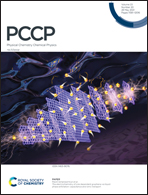Encapsulating aluminum nanoparticles into carbon nanotubes for combustion: a molecular dynamics study†
Abstract
Metal nanoparticles are easily deactivated by migration–aggregation in combustion. Encapsulated nanoparticles are one of the tools for coping with the stability challenges of metal nanoparticles. The self-assembly details of aluminum nanoparticles (ANPs) encapsulated into carbon nanotubes (CNTs) were demonstrated by molecular dynamics simulations. The simulation results show that ANPs can completely self-roll into CNTs to form a stable core–shell structure by inertial force and van der Waals force. Inside the tubes, ANPs move toward the cap at a velocity of 2.27 Å ps−1. However, it increases to 3.17 Å ps−1 when near the cap of CNTs. The initiation of the ANPs’ oxidation and degradation can be effectively checked by coating CNTs. The diffusion of the Al atoms in the encapsulated ANPs occurred earlier than their oxidation in combustion, verified by using ReaxFF molecular dynamics simulations. The morphological evolutions of the nanostructures in the initial combustion of the encapsulated ANPs are predicted. The interplay between the encapsulated ANPs’ responses and external stimuli is classified into core–shell separation, shell damage, and core–shell burst, which provides insights into the oxidation mechanism of encapsulated nanoparticles.



 Please wait while we load your content...
Please wait while we load your content...